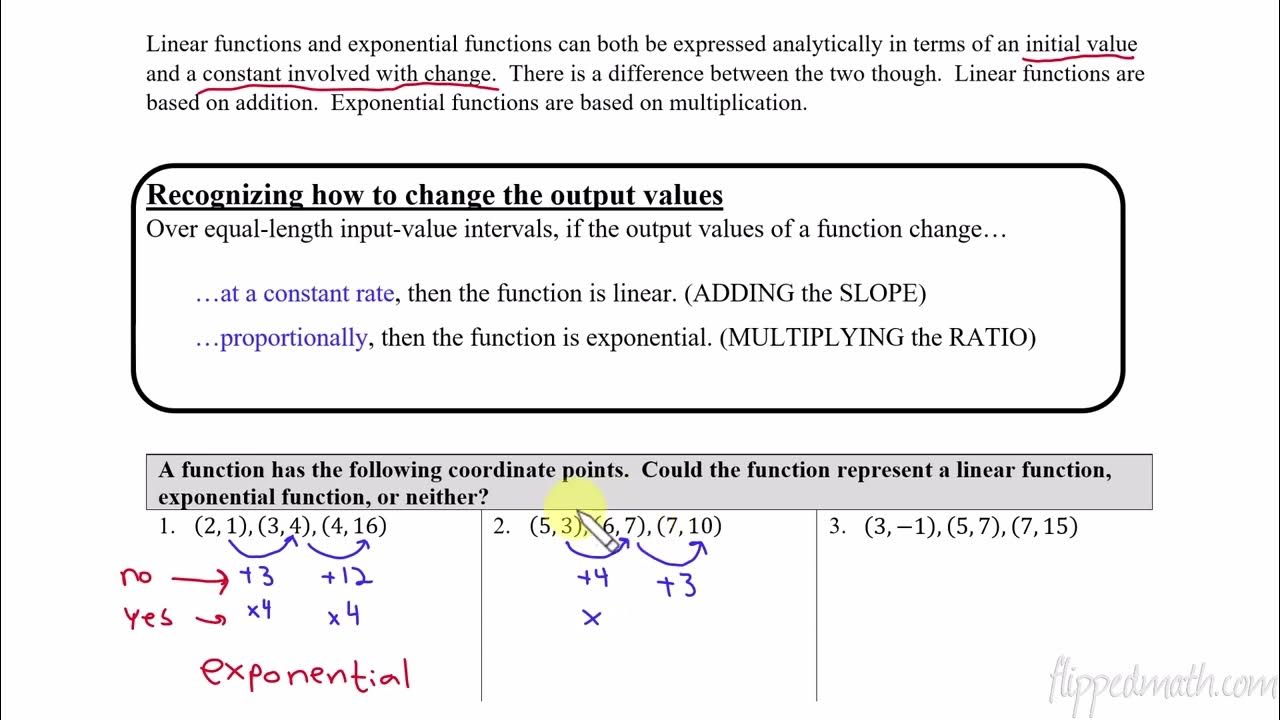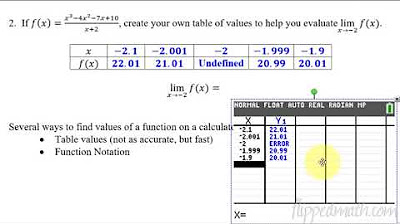Calculus AB/BC – 1.6 Determining Limits Using Algebraic Manipulation
Summary
TLDRIn this calculus lesson, Mr. Bean explores algebraic manipulation to find limits of functions. He begins with direct substitution, demonstrating how to plug in the value x approaches to find the limit. Moving on, he addresses indeterminate forms by factoring and canceling, simplifying expressions for easier limit determination. Mr. Bean also covers cases where limits do not exist, using algebraic manipulation to show this. The video concludes with special trigonometric limits, offering shortcuts and memorization tips for sine and cosine functions as x approaches zero, and a sneak peek at the next lesson's challenges.
Takeaways
- 📚 Direct Substitution: The simplest method to find a limit by plugging in the value of x the function approaches.
- 📈 Constant Functions: For limits involving constants, the y-value remains constant regardless of the x-value approached.
- 🔍 Indeterminate Forms: When direct substitution results in 0/0 or similar forms, algebraic manipulation is needed to find the limit.
- 🔄 Factor and Cancel: Factoring expressions can help simplify and resolve indeterminate forms by canceling common factors.
- 📉 Limits that Don't Exist: If after simplification, the expression cannot be evaluated at the approached value, the limit does not exist.
- 📊 Trigonometric Limits: Special trigonometric limits, like sine x over x approaching zero, have specific values and should be memorized.
- 📐 Vertical Asymptotes: Expressions that cannot be simplified to find a limit may indicate a vertical asymptote on the graph.
- 🔢 Memorization Techniques: Associating the appearance of sine and cosine with the numbers one and zero can help remember special trig limits.
- 🛠 Algebraic Manipulation: Understanding how to manipulate expressions algebraically is key to finding limits, even without graphing.
- ✂️ Shortcuts in Trig Limits: Multiplying the expression by a form of one (like x/x) can simplify the process of finding trigonometric limits.
- 🔄 Difference of Squares: Recognizing and factoring expressions like cosine squared x - 1 can simplify the process of finding limits.
Q & A
What is the main topic of the calculus lesson presented by Mr. Bean?
-The main topic of the lesson is algebraic manipulation for finding limits in calculus.
What does 'direct substitution' mean in the context of finding limits?
-Direct substitution refers to the method of finding a limit by simply plugging in the value of x that the limit is approaching into the given expression.
How does the graph of a parabola like x^2 + 2x - 4 behave as x approaches -1?
-As x approaches -1, the graph of the parabola x^2 + 2x - 4 approaches a y-value of -5, which is determined by direct substitution.
What is the result of the limit as x approaches 2 for the expression y = 6?
-The result of the limit as x approaches 2 for the expression y = 6 is 6, because it is a constant value and does not depend on x.
What is an indeterminate form in calculus?
-An indeterminate form in calculus occurs when an expression results in 0/0 or similar undefined expressions, which cannot be directly evaluated to find a limit.
How can you simplify an expression that results in an indeterminate form?
-You can simplify an expression with an indeterminate form by factoring and canceling common factors to make the limit determinable through direct substitution.
What is the limit of the expression (4x - 5) / x as x approaches 0?
-The limit of the expression (4x - 5) / x as x approaches 0 is -5, after simplifying and using direct substitution.
How can you determine if a limit does not exist for a given expression?
-A limit does not exist if, after simplification, you cannot substitute the value of x that the limit is approaching, or if the left and right limits approach different values.
What is a special trigonometric limit that Mr. Bean mentioned in the lesson?
-One of the special trigonometric limits mentioned is sin(x)/x as x approaches 0, which approaches a value of 1.
How can you quickly find the limit of sin(ax)/x as x approaches 0?
-The quick way to find the limit of sin(ax)/x as x approaches 0 is to recognize that it is equivalent to 'a' times the limit of sin(x)/x, which is 'a'.
What is the result of the limit for the expression (cosine squared x - 1) / x as x approaches 0?
-The result of the limit for the expression (cosine squared x - 1) / x as x approaches 0 is 0, after factoring and canceling terms.
Outlines

This section is available to paid users only. Please upgrade to access this part.
Upgrade NowMindmap

This section is available to paid users only. Please upgrade to access this part.
Upgrade NowKeywords

This section is available to paid users only. Please upgrade to access this part.
Upgrade NowHighlights

This section is available to paid users only. Please upgrade to access this part.
Upgrade NowTranscripts

This section is available to paid users only. Please upgrade to access this part.
Upgrade NowBrowse More Related Video

Calculus (Version #2) - 1.1 Limits Graphically

AP Precalculus – 2.2 Change in Linear and Exponential Functions

Calculus AB/BC – 1.4 Estimating Limit Values from Tables

Calculus AB/BC – 1.10 Exploring Types of Discontinuities

Calculus AB/BC – 2.1 Defining Average and Instantaneous Rate of Change at a Point

Calculus BC – 10.12 Lagrange Error Bound
5.0 / 5 (0 votes)